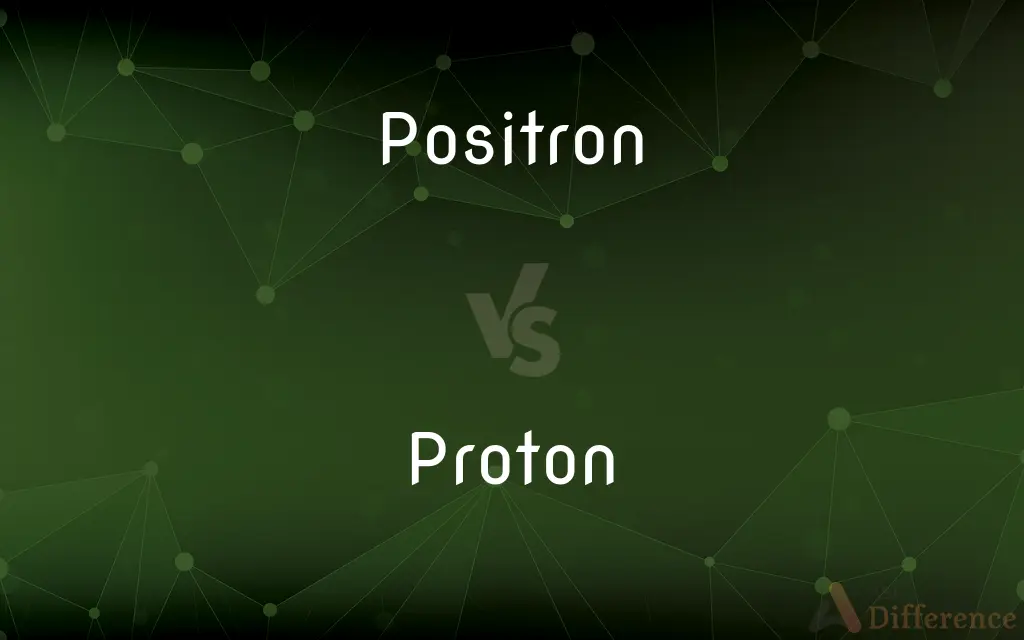Positron vs. Proton — What's the Difference?
Edited by Tayyaba Rehman — By Fiza Rafique — Updated on September 22, 2023
A positron is an antimatter counterpart of the electron with a positive charge. A proton is a baryon particle found in the nucleus of atoms with a positive charge.

Difference Between Positron and Proton
Table of Contents
ADVERTISEMENT
Key Differences
A positron is an elementary particle with a positive electric charge, serving as the antimatter counterpart to the negatively charged electron. A proton, on the other hand, is a baryon, a composite particle made of three quarks, and resides in the atomic nucleus with a positive charge. Both have a fundamental role in physics, but they are involved in different processes and exist in different contexts.
The positron is often encountered in the field of particle physics and in technologies like positron emission tomography (PET) scans. The proton is central to atomic physics and forms the nucleus of hydrogen atoms. Both are positively charged, but their functions in scientific applications differ dramatically.
Positrons are typically created through high-energy processes and generally annihilate upon contact with electrons, releasing energy in the form of gamma rays. Protons are stable particles that do not readily annihilate and are key building blocks in the formation of elements. Both particles contribute to our understanding of the universe but in disparate ways.
The mass of a positron is approximately 9.11×10−31 kilograms, the same as that of an electron. A proton is much heavier, with a mass approximately 1836 times that of an electron or positron. Thus, while both positrons and protons carry a single positive charge, their masses and roles in matter are entirely different.
Comparison Chart
Charge
+1e
+1e
ADVERTISEMENT
Mass
~9.11×10−31 kg
~1.67×10−27kg
Composition
Elementary particle
Made of 3 quarks
Stability
Unstable (annihilates with electrons)
Stable
Applications
Particle physics, PET scans
Atomic physics, chemistry
Compare with Definitions
Positron
A positron is the antimatter counterpart of an electron.
In a PET scan, the annihilation of positrons and electrons is detected to create images.
Proton
A proton is a baryon made up of three quarks.
The internal structure of a proton includes up and down quarks held together by the strong force.
Positron
A positron is an elementary particle with a positive electric charge.
The positron has the same amount of charge as an electron but with an opposite sign.
Proton
A proton has a mass approximately 1836 times that of an electron.
The large mass of the proton contributes to the mass of atomic nuclei.
Positron
A positron is unstable and annihilates upon contact with an electron.
When a positron encounters an electron, both particles are annihilated, releasing gamma rays.
Proton
A proton is a stable particle that does not readily annihilate.
Unlike positrons, protons are stable and do not annihilate when they meet other particles.
Positron
A positron has the same mass as an electron but with a positive charge.
Despite having opposite charges, the mass of a positron is identical to that of an electron.
Proton
A proton is a positively charged particle found in atomic nuclei.
The hydrogen atom consists of one proton and one electron.
Positron
A positron is created in high-energy processes like beta-plus decay.
In some radioactive decays, a nucleus emits a positron.
Proton
A proton is essential for the formation of elements.
Without protons, the variety of elements in the periodic table would not exist.
Positron
The positron or antielectron is the antiparticle or the antimatter counterpart of the electron. The positron has an electric charge of +1 e, a spin of 1/2 (the same as the electron), and has the same mass as an electron.
Proton
A proton is a subatomic particle, symbol p or p+, with a positive electric charge of +1e elementary charge and a mass slightly less than that of a neutron. Protons and neutrons, each with masses of approximately one atomic mass unit, are jointly referred to as "nucleons" (particles present in atomic nuclei).
Positron
An elementary particle having the same mass and magnitude of charge as an electron but exhibiting a positive charge; the antiparticle of the electron. Also called antielectron.
Proton
The stable, positively charged nucleon, having a mass 1,836 times that of an electron and being a baryon composed of two up quarks and one down quark. The proton is a basic component of all atomic nuclei and the nucleus of the protium isotope of hydrogen.
Positron
(particle) The antimatter equivalent of an electron, having the same mass but a positive charge
The notion of a positron weapon remains the stuff of science fiction.
Proton
(particle) A positively charged subatomic particle forming part of the nucleus of an atom and determining the atomic number of an element, composed of two up quarks and a down quark.
Positron
An elementary particle with positive charge; interaction of a positron and an electron results in annihilation
Proton
The atomic nucleus of protium hydrogen-1}}
Proton
Synonym of primordium
Proton
A stable particle with positive charge equal to the negative charge of an electron
Common Curiosities
Can a positron exist freely in nature?
Positrons are generally unstable and annihilate upon contact with electrons.
What is a positron?
A positron is the antimatter counterpart of an electron with a positive electric charge.
What is the charge of a proton?
A proton carries a single positive electric charge, symbolized as +1e.
Are protons stable?
Yes, protons are stable particles that do not readily annihilate.
How do positrons interact with electrons?
Positrons and electrons annihilate upon contact, releasing energy in the form of gamma rays.
What are the applications of positrons?
Positrons are used in particle physics experiments and medical imaging like PET scans.
Do protons and positrons have the same charge?
Yes, both protons and positrons have a single, positive electric charge.
What are the applications of protons?
Protons are crucial in atomic physics, chemistry, and even in cancer treatment through proton therapy.
What is a proton?
A proton is a positively charged particle found in the nucleus of an atom.
How are positrons created?
Positrons are often created in high-energy processes like beta-plus decay.
How do protons contribute to atomic mass?
Protons significantly contribute to the mass of an atom since they are much heavier than electrons.
Are positrons heavier than electrons?
No, positrons and electrons have the same mass.
Can protons and positrons form a stable system together?
No, protons and positrons do not readily form a stable system due to their differing roles in matter and energy levels.
What makes up a proton?
A proton is a composite particle made of three quarks.
How are positrons detected?
Positrons are often detected using specialized detectors that capture the gamma rays emitted upon their annihilation with electrons.
Share Your Discovery

Previous Comparison
Hibachi vs. Teppanyaki
Next Comparison
Gears vs. SprocketAuthor Spotlight
Written by
Fiza RafiqueFiza Rafique is a skilled content writer at AskDifference.com, where she meticulously refines and enhances written pieces. Drawing from her vast editorial expertise, Fiza ensures clarity, accuracy, and precision in every article. Passionate about language, she continually seeks to elevate the quality of content for readers worldwide.
Edited by
Tayyaba RehmanTayyaba Rehman is a distinguished writer, currently serving as a primary contributor to askdifference.com. As a researcher in semantics and etymology, Tayyaba's passion for the complexity of languages and their distinctions has found a perfect home on the platform. Tayyaba delves into the intricacies of language, distinguishing between commonly confused words and phrases, thereby providing clarity for readers worldwide.
















































